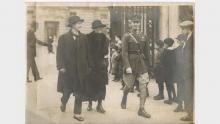William Victor Bevan
William Victor Bevan was born in Bulli, N.S.W.
At enlistment, he was single, 23 years old, worked as a school teacher and lived in Thirroul, N.S.W. William had served 3 years with the Senior Cadets, and had attended the coronation of King George V, as part of the Australian Commonwealth Coronation Contingent. He was gazetted as 2nd Lieutenant in December 1911.
On 8th March 1916, William embarked on HMAT A15 Star of England, with 4th Battalion, 15th Reinforcement, as a 2nd Lieutenant. He initially arrived in Egypt, then on 29th June 1916, he went to France, where he joined the 53rd Battalion on 16th September 1916. William saw service on the Western Front, and in England, as a trainer and infantry soldier. He was promoted to Lieutenant on 26th January 1917, and then to Captain on 27th January 1919.
In 1919, William was awarded the Military Cross for his actions at Peronne, France, and received his medal from the King George V, at Buckingham Palace. He returned to Australia in July 1919, and was discharged on 27th October 1919. On his return to Australia, William returned to teaching.
On 18th January 1930, William married Annie Graham, in Maitland, N.S.W., where they raised their 5 children.
On 1st February 1941, he enlisted for service in World War 2, as Lieutenant Bevan (Service No N106253), and served with the 8th Garrison Battalion, C Company, at the rifle range at Adamstown, N.S.W. William then served in Townsville, Qld, before going to New Guinea, in January 1943. He served in Port Morseby and at Milne Bay. William returned to Australia, soon after, due to the health of his wife, who was dying from cancer.
William died in Maitland, N.S.W., in 1962.
He is commemorated for his service on the Thirroul Cenotaph, Woodward Memorial Park, Lawrence Hargrave Drive, Thirroul.
William's brother Rhys Bevan (Service No 2524), also served.
The citation for his Military Cross reads;
"During the advance on Peronne on 1st September, 1918, he led his platoon forward with great gallantry in face of heavy Artillery and Machine Gun fire. On reaching his final objective he found his flanks exposed and the enemy behind him. Nevertheless, he fought his way back with great skill and determination through a nest of machine guns, killing many of the enemy, and eventually rejoined his company. His splendid example of resolution and tenacity inspired all under his command."
Commonwealth Gazette No 67
Dated 3rd June 1919.
Links
-
William Victor Bevan - Australian War Memorial documents
- https://www.awm.gov.au/collection/P10671471, https://www.awm.gov.au/collection/P10186332, https://www.awm.gov.au/collection/P10821757, https://www.awm.gov.au/collection/P10140255
-
William Victor Bevan - AIF Project
- https://www.aif.adfa.edu.au/showPerson?pid=21979


